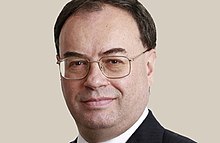| Governor of the Bank of England | |
|---|---|
 Seal of the Bank of England | |
since 16 March 2020 | |
| Monetary Policy Committee Governor and Company of the Bank of England | |
| Residence | London, United Kingdom |
| Appointer | Chancellor of the Exchequer[1][2] with the approval of the Prime Minister[3] and the Monarch[4] |
| Term length | 8 years Renewable once |
| Inaugural holder | Sir John Houblon |
| Formation | 1694 |
| Salary | £495 000 [5] |
| Website | Governor of the Bank of England |
The governor of the Bank of England is the most senior position in the Bank of England. It is nominally a civil service post, but the appointment tends to be from within the bank, with the incumbent grooming their successor. The governor of the Bank of England is also chairman of the Monetary Policy Committee, with a major role in guiding national economic and monetary policy, and is therefore one of the most important public officials in the United Kingdom.
According to the original charter of 27 July 1694 the bank's affairs would be supervised by a governor, a deputy governor, and 24 directors.[6] In its current incarnation, the bank's Court of Directors has 12 (or up to 14) members, of whom five are various designated executives of the bank.[7]
The 121st and current governor is Andrew Bailey, who began his term in March 2020.[8]
- ^ Chu, Ben (27 November 2012). "George Osborne gets his man: Mark Carney named as new Bank of England Governor". The Independent. Retrieved 2 April 2020.
The panel put forward Mr Carney's name to the Chancellor, who then consulted the Prime Minister and the Deputy Prime Minister before announcing his decision.
- ^ Partington, Richard (20 December 2019). "Andrew Bailey appointed head of Bank of England". The Guardian. Retrieved 2 April 2020.
Javid is understood to have decided on Bailey.
- ^ Mackenzie, Nell (24 December 2019). "Why didn't the Bank of England appoint a woman?". BBC News. Retrieved 4 April 2020.
Andrew Bailey was appointed by the government, not the Bank: chosen by Chancellor Sajid Javid and approved by the prime minister.
- ^ "Andrew Bailey announced as new Governor of the Bank of England". Bank of England. 20 December 2019. Retrieved 2 April 2020.
The Chancellor has announced that Andrew Bailey will become the new Governor of the Bank of England from 16 March 2020. Her Majesty the Queen has approved the appointment.
- ^ "Bank of England: What does the governor do?". BBC.com. 20 December 2019. Retrieved 21 December 2020.
- ^ Richards, Richard. The Early History of Banking in England (Rle Banking and Finance). p. 152.
- ^ "Court of Directors". Retrieved 2018-07-24.
- ^ "Andrew Bailey". www.bankofengland.co.uk. Retrieved 2020-03-16.
